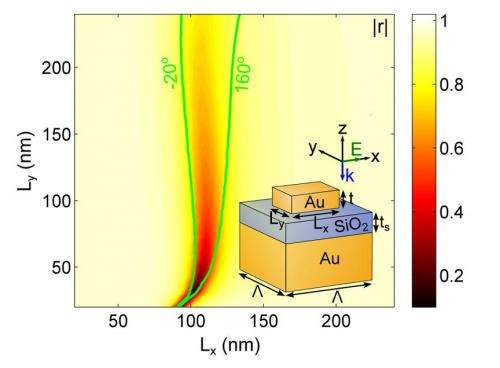January 12, 2015 feature
Metasurface solves calculus problems as an analog computer

Scientists have demonstrated that a 2-D man-made material called a metasurface can perform spatial differentiation and integration, the two main types of calculus problems, when illuminated by a laser beam. Essentially, the metasurface transforms the shape of the incoming light wave profile (the input) into the shape of its derivative or integral (the output). The achievement requires very precise control of light at the nanoscale—specifically, controlling both the amplitude and the phase of the reflected light at the same time.
The researchers, Anders Pors, Michael G. Nielsen, and Sergey I. Bozhevolnyi at the University of Southern Denmark, have published their paper on the new metasurface in a recent issue of Nano Letters.
Somewhat unexpectedly, the work builds on recent research on analog computing, which is based on continuous values, rather than incremental values as used digital computing. The new metasurface uses continuous values of the phase and amplitude of light to perform the calculus operations, making it an example of analog computing.
The concept of analog computers may conjure up images of slide rules and other old-fashioned tools that were replaced by digital computers in the 1960s and '70s. But last year, a team of researchers (A. Silva, et al.) presented simulations suggesting that metamaterials can perform computational tasks in an analog fashion—that is, by using continuous optical fields rather than discrete bits to represent data.
That work showed that metasurfaces have the advantage of being extremely thin—orders of magnitude smaller than conventional optical elements such as bulky lenses or wave plates. Their thinness potentially allows for the design of miniaturized, compact optical circuits, with analog computing as one unique application.
In the new study, the researchers from Denmark demonstrated a practical approach to realize compact analog computing using metasurfaces. In general, metasurfaces consist of an array of tiny metallic scatterers that are smaller than the wavelength of the light passing through them.

Here, the researchers used gold nanobricks as the scatterers, placed on top of a silicon dioxide spacer and a gold film. When an 800-nm laser beam illuminates the metasurface, the light excites gap-surface plasmons that propagate in the spacer region between the nanobricks and gold film, resulting in reflected light whose amplitude and phase are determined by the sizes of the nanobricks.
While amplitude and phase have previously been controlled individually, this study marks the first time that the two properties are controlled simultaneously and independently by varying the dimensions of the metallic scatterers, representing unprecedented control of light at the nanoscale.
"We believe the greatest significance is, in fact, not analog computing but the possibility to simultaneously control the amplitude and phase of reflected light at visible frequencies," Pors told Phys.org. "As mentioned in the conclusion of the article, this allows for new operations of metasurfaces, like the generation of complex wave fronts or information storage in (phase- and amplitude-controlled) holograms. Moreover, one could envision metasurface plates being used as add-ons in optical microscopes—for example, for edge-detection imaging by calculating the second derivative, or phase imaging using a Zernike plate."
He explained that there are several potential advantages of analog computing that have attracted recent attention to the subject.
"The renewed interest comes from the possibility of using light instead of an electrical signal or mechanical motion, which can allow for faster computation in a compact setup," Pors said. "In general, researchers hope in the future to replace electrical signals with light because the frequency of light is much higher than GHz operation typically used in electronics. Light, however, cannot conventionally be squeezed down to the dimensions of electronics, which is the reason why electronics dominates, with light mainly being used to transfer huge amounts of data over long distances. Regarding analog versus digital computation, analog computations have the advantage that the input signal doesn't have to be converted to a digital stream of bits, meaning that analog operations don't suffer from conversion delays; i.e., it can be faster than digital computations."
In the future, the researchers plan to investigate the wider potential of metasurfaces.
"We will not solely focus on analog computing, but continue exploring the possibilities of using gradient metasurfaces to control light and design new spectacular/important functionalities," Pors said.
More information: Anders Pors, et al. "Analog Computing Using Reflective Plasmonic Metasurfaces." Nano Letters. DOI: 10.1021/nl5047297
Journal information: Nano Letters
© 2015 Phys.org





















